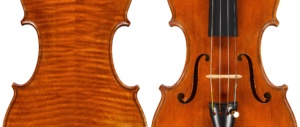Last week I introduced the Balestrieri, Vuillaume and Testore from our March auction and this week I want to share seven modern Italian instruments from the sale. From Turin there are violins by Evasio Emilio Guerra and Enrico Clodoveo Melegari. Both are in near mint condition, and the Guerra is still fitted with its original bridge from the maker. There are fine examples from the Milanese school by Pedrazzini, Mandelli, Monzino, and an early violin by Sesto Rocchi from when he was working with Leandro Bisiach. And finally, we present a viola by Pietro Sgarabotto working under the guidance of his father Gaetano. It’s an exciting sale with many other great lots, and the catalog will be available online after March 3. We look forward to seeing you at the viewings, virtual or in person!

Evasio Emilio Guerra, Turin, 1940
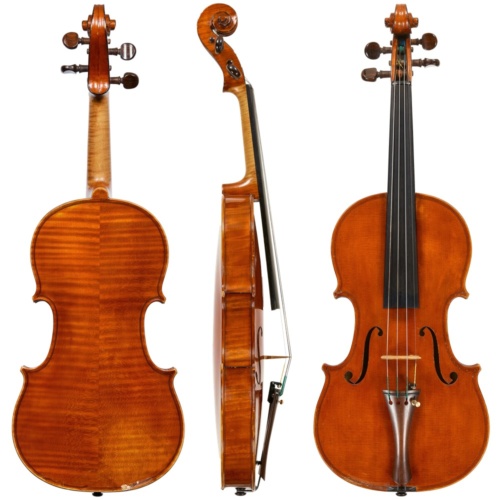
This violin is based on a Stradivari pattern and is one of Guerra’s most successful models.
This exceptionally pure violin by Evasio Emilio Guerra (1875-1956) epitomizes classic mid-20th century Turin lutherie. Originally a violinist, Guerra was of the same generation as Fagnola and Oddone but took up violin making much later. The first instruments to bear his label appear just after the turn of the 20th century.
The model of the present instrument is Guerra’s most successful: a Stradivari pattern with broad bouts and flat arching. The ribs are also full: 32.5 mm at the lower block and 30.0 at the upper. The scroll chamfer and rib mitres are blackened and a pronounced scribe line is visible along the ridge at the back of the head as is typical of Turin instruments. It seems the instrument has never been opened and it is still fitted with its original bridge.

Enrico Clodoveo Melegari, Turin, 1885
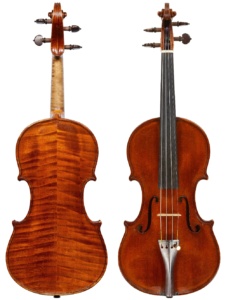
The instruments of Enrico Clodoveo Melegari (1835-1895) are singular and full of character. His scrolls are among the most easily recognizable of all makers with a deep throat, an oval volute, a rounded eye, but almost no chamfer. The front of the head is slight, reaching 9.3 mm at the narrowest point. The pegbox walls are sturdy and visually accentuated by the undersized chamfer. The round base of the back of the head is oval and not formed with a compass. Like most Turin makers after Pressenda, a bold scribe line separates the left and right halves of the head.
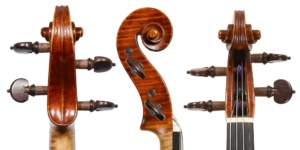
The ruby-red varnish which penetrates into the wood is also reminiscent of Pressenda. Sometimes Melegari violins are oversized in body-length but this violin is 35.4 cm. It bears the maker’s brand internally, on the lower rib and to the bottom of the pegbox floor.
Sesto Rocchi, Varese, 1933
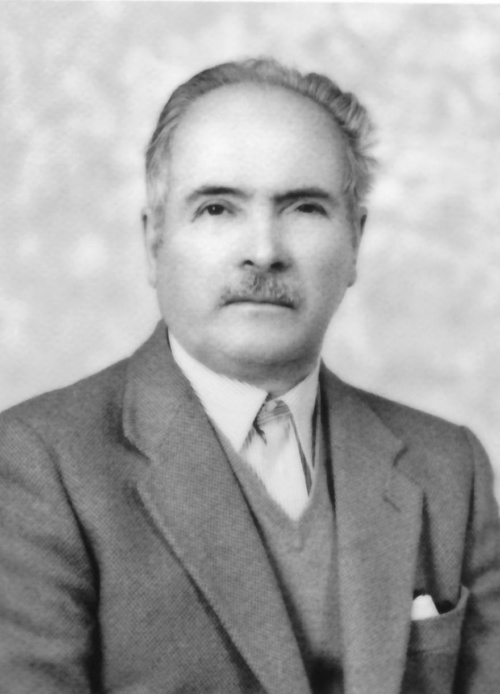
The early violins of Sesto Rocchi (1909-1991) are exceptional. Our March sale includes a great 1933 violin, made while Rocchi was studying with Leandro Bisiach at his home outside Milan in Varese. After studying with Sgarabotto in Parma, Rocchi went to live and further perfect his craft under the tutelage of Bisiach in Varese in 1931. Bisiach’s influence is evident in this charismatic violin. We especially love the label: banged out on a mechanical typewriter with a border composed of quotation marks.

Rocchi’s spirited label decorated with a quotation pattern.
Also note that this is probably a January violin, meaning it was probably in construction between December and January. The upper and lower blocks are inscribed 1932 but the label is dated ‘1933’. In the inscription we find a cute pun: Sesto means “sixth” in Italian and here the maker playfully inscribes “Rocchi VI”.
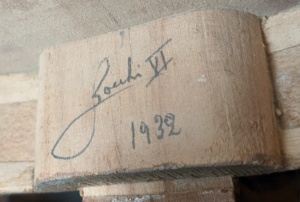
Camillo Mandelli “Da Calco”, Milan, 1929
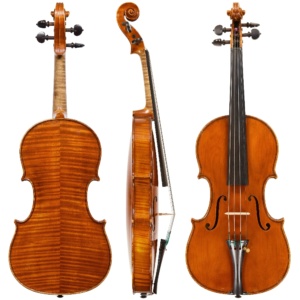
Camillo Mandelli (1873-1956) was born in Calco, a small town in the province of Lecco, just north of Milan. He trained with Leandro Bisiach and the Antoniazzi brothers, before emigrating to Buenos Aires in 1889. In Argentina he adopted the moniker “Camillo da Calco”, Camillo from Calco.
He returned to Italy in 1920 and took up residence again in Calco. The instruments made between 1920-1930 are his most interesting. His return to Italy exposed him to all the great making that was happening in Milan in the 1920s and encouraged him to perfect his craft. This fine example from 1929 is in excellent condition. The back is formed of a very attractive maple, the spruce is of fine and even grain. The slender soundholes with diminutive notches, the compact rolled edges, and the lustrous orange varnish are distinctive of this maker and point to his early training in the Antoniazzi style.
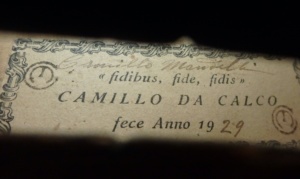
Pedrazzini Workshop, Milan, 1931
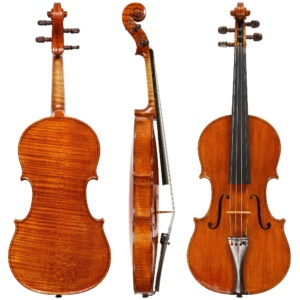
There was a wide range of instruments produced in the workshop of Giuseppe Pedrazzini (1879-1957). He had a long-standing relationship with the London firm of Hawkes & Son who, between 1911 to 1938, sold many instruments by Pedrazzini. While these instruments are labeled and branded in the usual manner, they bear a second label which makes clear that Hawkes & Son are the SOLE AGENTS of Pedrazzini. This violin dating from 1931 bears the “Sole Agents” label as well as the block-capital “G. PEDRAZZINI” brand and the original Pedrazzini label. The top margin of the Pedrazzini label reads “Officina (di liuteria)” or workshop (of violin making).
The violin is sold with a receipt from January 11, 1975 when it was purchased from Ealing Strings by the current owner.
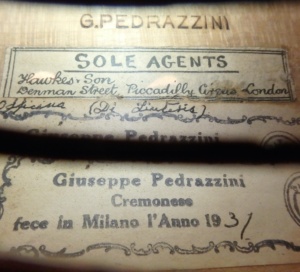
Pedrazzini’s double label and brand.
Antonio Carlo Monzino, Milan, 1929
Antonio Carlo Monzino (1909-2004) was the last in a long line of Milanese makers of this name. His great-great-great grandfather, Antonio Monzino I (1799–1872), opened a shop which made and sold “instruments and strings” in c. 1750. Over the following two centuries the firm became Milan’s largest musical emporium; not only did it make, sell, deal, import, and repair violins, mandolins, guitars, harps, and other instruments, the Monzino company also published music and produced strings and accessories. In the early years of the 20th century, the firm employed, at various times, several of Milan’s most important makers including the Antoniazzi brothers, Ambrogio Sironi, Pierro Parravicini, and Luigi Galimberti, among others.
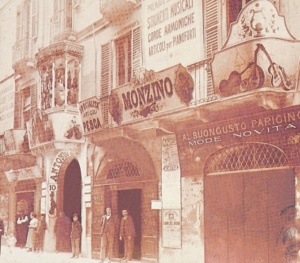
Milan’s largest music shop, the Monzino Emporium (Fondazione Antonio Carlo Monzino ©2021).
This violin dated 1929 is the work of Antonio Carlo Monzino. Not all of the Monzino were makers but Antonio Carlo did study in both Mirecourt and Markneukirchen. He entered the family firm under the direction of his grandfather, his own father having died of the Spanish flu. Luigi Galimberti (1888-1957) and Piero Parravicini (1889-1957) were both in the employ or orbit of the Monzino firm in 1929 and we can only imagine the attention and mentoring that the boss’s son might have received from these skilled makers.
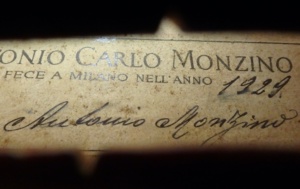
In this violin we see the strong influence of Galimberti: the thin waist, the precisely cut slanted sound-holes with razor-sharp notches, the slightly pinched corners, the purfling with heavy black inner and outer strips and the neatly carved head with its narrow chamfer and deep fluting.
Pietro Sgarabotto, Parma, 1947

Pietro Sgarabotto (1903-1990) learned violin making from his father Gaetanno. This viola, made in 1947, is 41.9 cm in length and an excellent model for modern playing requirements. One special quirk of the Parma tradition of violin making is that the major makers of the 20th century often named their instruments after historical figures, taking inspiration from the arts, music or history. The title of this viola is “Giovanna D’Arco”, or Joan of Arc. This tradition was started by Gaetanno Sgarabotto, continued by his son Pietro, and followed by many of their students including Sesto Rocchi and Renato Scrollavezza. In the Parma school today, Eliza Scrollavezza and Andrea Zanrè keep alive this tradition. In their recent monograph on Sgarabotto, Scrollavezza and Zanrè note that the initials “S.G.” on the label usually indicate the involvement of Pietro’s father, Gaetano.
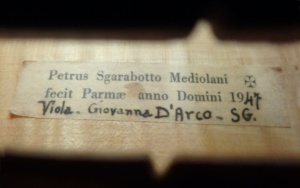
There are many other exciting instruments in the sale. The online catalog posts March 3rd.
